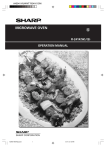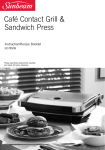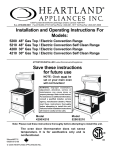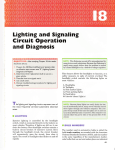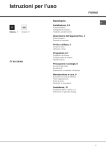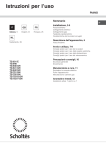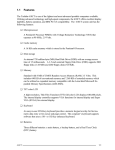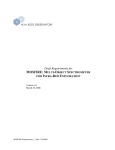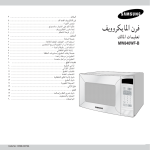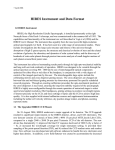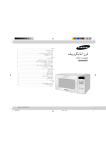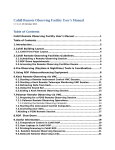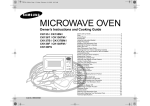Download LG MH6382BS microwave
Transcript
OWNER’S MANUAL
MICROWAVE OVEN
Please read this owner’s manual thoroughly before operating.
MS2042X
MS5642G
MFL67581802
www.lg.com
Precautions
Precautions to avoid possible exposure to excessive microwave energy.
You cannot operate your oven with the door open due to the safety interlocks built into the door mechanism.
These safety interlocks automatically switch off any cooking activity when the door is opened; which in the case of
a microwave oven could result in harmful exposure to microwave energy.
It is important not to tamper with the safety interlocks.
Do not place any object between the oven front face and the door or allow food or cleaner residue to accumulate
on sealing surfaces.
Do not operate your oven if it is damaged. It is particularly important that the oven door closes properly and that
there is no damage to the: (1) door(bent), (2) hinges and latches (broken or loosened), (3) door seals and sealing
surfaces.
Your oven should not be adjusted or repaired by anyone except qualified service personnel.
• Utensils should be checked to ensure that they are suitable for use in microwave ovens.
• When heating food in plastic or paper containers, check the oven frequently due to the possibility of ignition.
• If smoke is observed, switch off or unplug the appliance and keep the door closed in order to stifle any
flames.
• Microwave heating of beverages can result in delayed eruptive boiling. Therefore care has to be taken when
handing the container.
• The contents of feeding bottles and baby food jars are to be stirred or shaken and the temperature is to be
checked before consumption, in order to avoid burns.
• Eggs in their shell and whole hard-boiled eggs shall not be heated in microwave ovens since they may explode.
CLEANING
NOTE: Before cleaning the oven, unplug the power
cord. If this is impossible, open the oven door to
prevent an accidental oven start.
The oven should be cleaned regularly and any food
deposits removed
INTERIOR
Wipe the oven inside and outside with a soft cloth and
a mild detergent solution. Then rinse and wipe dry. This
should be done weekly or more often, if needed. Never
use cleaning powders or rough pads.
Excessive oil splatters on the inside top will be difficult
to remove if left for many days. Wipe splatters with a
wet paper towel, especially after cooking chicken or
bacon.
DOOR
For best performance and safety, the inner door panel
and the oven front frame should be free of food or
grease buildup. Wipe often with a mild detergent; then
rinse and wipe dry. Never use cleaning powders or
rough pads.
After cleaning the control panel, touch CLEAR to clear
any entries that might have been entered accidentally
while cleaning the panel. Also make sure that the
turntable and rotating ring are in the right position.
Failure to maintain the oven in a clean condition could
lead to deterioration of the surface that could adversely
affect the life of the appliance and possibly result in a
hazardous situation
REMOVABLE PARTS
The turntable and rotating ring are removable. They
should be hand-washed in warm (not hot) water with a
mild detergent and a soft cloth. Once they are clean,
rinse well and dry with a soft cloth. Never use cleaning
powders, steel wool, or rough pads.
• The turntable may be cleaned at the sink. Be careful
not to chip or scratch the edges as this may cause
the turntable to break during use.
• The rotating ring should be cleaned regularly.
2
Precautions
Warning
Please ensure cooking times are correctly set as over cooking may result in
the FOOD catching fire and subsequent damage to your oven.
When heating liquids, e.g. soups, sauces and beverages in your microwave oven, overheating the liquid beyond
boiling point can occur without evidence of bubbling. This could result in a sudden boil over of the hot liquid. To
prevent this possibility the following steps should be taken:
1. Avoid using straight sided containers with narrow necks.
2. Do not overheat.
3. Stir the liquid before placing the container in the oven and again halfway through the heating time.
4. After heating, allow to stand in the oven for a short time, stir or shake them again carefully and check the
temperature of them before consumption to avoid burns (especially, contents of feeding bottles and baby food
jars).
Warning
Always allow food to stand after being cooked by microwaves
and check the temperature of them before consumption.
Especially contents of feeding bottles and baby food jars.
• WARNING: If the door or door seals are damaged, the oven must not be operated until it has been repaired by
a trained person.
• WARNING: It is hazardous for anyone other than a trained person to carry out any service or repair operation
which involves the removal of any cover which gives protection, against exposure to microwave energy.
• WARNING: Liquids or other foods must not be heated in sealed containers since they are liable to explode.
• WARNING: Only allow children to use the oven without supervision when adequate instructions have been
given so that the child is able to use the oven in a safe way and understands the hazards of improper use.
3
Table of Contents
4
5
6
Technical Specifications
Installation
Introduction
How The Microwave Oven Works
Getting The Best Results From Your Microwave Oven
How Food Characteristics Affect Microwave Cooking
Special Techniques In Microwave Cooking
Microwave-Safe Utensils
9
10
Feature Diagram / Control Panel
Using Your Microwave Oven
Timed Cooking
2 Stage Timed Cooking
Microwave Power Levels
Child Lock
Kitchen Timer
Ez-On
More/Less
Auto Touch
Auto Cook
Auto Reheat
Fast Breakfast
Q Defrost
Energy Saving
Chicken Choices
Melt
Soften
Auto Defrost
20
21
Safety Precautions
Questions And Answers
Technical Specifications
MS2042X/MS5642G
Power Input
230V AC~50Hz
220V AC~50/60Hz
240V AC~50Hz
1,000W
Output
Microwave Frequency
2,450 MHz
Outside Dimensions
607 mm(W) X 344 mm(H) X 492 mm(D)
Cavity Dimensions
444 mm(W) X 277 mm(H) X 471 mm(D)
1,400W
Power Consumption
4
Installation
Install your oven by following three simple steps:
1. Remove all packing materials and accessories.
2. Place the oven in the level location of your choice with more than 85cm height but make sure there is at least
10 cm of space on the top and 10cm at the rear for proper ventilation. The side of the oven should be kept clear
so there is air flow for ventilation.
An exhaust outlet is located on top or side of the oven. Blocking the outlet can damage the oven.
3. Plug your oven into a standard voltage household outlet. Be sure the electrical circuit is at least 13 amps
and that your microwave oven is the only appliance on the circuit.
NOTE: • If your oven does not operate properly, unplug it from the AC household outlet and then
plug it back in.
• This appliance should not be used for commercial catering purposes.
WARNING : THIS APPLIANCE MUST BE EARTHED
IMPORTANT
The wires in the mains lead are coloured in accordance with the following codes :
Blue or White
Brown or Black
Green & Yellow or Green
- Neutral
- Live
- Earth
As the colours of the wires in the mains lead of this appliance may not correspond with the coloured
markings identifying the terminals in your plug, proceed as follows :
The wire which is coloured blue or white must be connected to the terminal which is marked with the letter
N or coloured black.
The wire which is coloured brown or black must be connected to the terminal which is marked with the
letter L or coloured red.
The wire which is coloured green & yellow or green must be connected to the terminal which is marked
with the letter E or
.
This utility article is provided with a mains cord of special performance, which in case it is damaged, must be
replaced with a mains cord of the same type ; such a mains cord can be obtained from importer and be
installed by a competent person.
5
Introduction
How the Microwave Oven Works
Microwaves are a form of energy similar to radio and
television waves and ordinary daylight. Ordinarily,
microwaves spread outwards as they travel through
the atmosphere and disappear without effect.
Microwave ovens, however, have a magnetron which
is designed to make use of the energy in microwaves.
Electricity, supplied to the magnetron tube, is used to
create microwave energy. These microwaves enter the
cooking area through openings inside the oven. A
turntable or tray is located at the bottom of the oven.
Microwaves cannot pass through metal walls of the
oven, but they can penetrate such materials as glass,
porcelain and paper, the materials out of which
microwave-safe cooking dishes are constructed.
Microwaves do not heat the cookware, though cooking
vessels will eventually get hot from the heat generated
by the food.
A very safe appliance. Your microwave oven is one
of the safest of all home appliances. When the door is
opened, the oven automatically stops producing
microwaves. Microwave energy is converted
completely to heat when it enters food, leaving no “left
over” energy to harm you when you cook your food.
For example, a cake made with ice-cold butter, milk,
and eggs will take considerably longer to bake than
one made with ingredients that are at room
temperature. All of the recipes in this book give a
range of cooking times. In general, you will find that
the food remains under-cooked at the lower end of the
time range, and you may sometimes want to cook your
food beyond the maximum time given, according to
personal preference. The governing philosophy of this
book is that it is best for a recipe to be conservative in
giving cooking times. While undercooked food is
ruined for good. Some of the recipes, particularly those
for bread, cakes, and custards, recommend that food
be removed from the oven when they are slightly
undercooked. This is not a mistake. When allowed to
stand, usually covered, these foods will continue to
cook outside of the oven as the heat trapped within the
outer portions of the foods gradually travels inward. If
the foods are left in the oven until they are cooked all
the way through, the outer portions will become
overcooked or even burnt. As you gain experience in
using your microwave oven, you will become
increasingly skillful in estimating both cooking and
standing times for various foods.
Getting The Best Results From Your
Microwave Oven
How Food Characteristics Affect
Microwave Cooking
Keeping an eye on things.The recipes in this book
have been formulated with great care, but your
success in preparing them depends, of course, on how
much attention you pay to the food as it cooks. Always
watch your food while it cooks. Your microwave oven
is equipped with a light that turns on automatically
when the oven is in operation so that you can see
inside and check the progress of your
recipe.Directions given in recipes to ‘elevate’, ‘stir’, and
the like should be thought of as the minimum steps
recommended. If the food seems to be cooking
unevenly, simply make the necessary adjustments you
think appropriate to correct the problem.
Density of foods: Light, porous food such as cakes
and breads cook more quickly than heavy, dense
foods such as roasts and casseroles. You must take
care when microwaving porous foods that the outer
edges do not become dry and brittle.
Factors affecting cooking times. To check the
wattage of your oven, refer to the specifications at the
beginning of this book. Many factors affect cooking
times. The temperature of ingredients used in a recipe
makes a big difference in cooking times.
Bone and fat content of foods: Bones conduct heat
and fat cooks more quickly than meat. Therefore, care
must be taken when cooking bony or fatty cuts of meat
that they do not cook unevenly and do not become
overcooked.
Height of foods: The upper portion of tall foods,
particularly roasts, will cook more quickly than the
lower portion. Therefore, it is wise to turn tall foods
during cooking, sometimes several times.
Moisture content of foods: Since the heat generated
from microwaves tends to evaporate moisture,
relatively dry foods such as roasts and some
vegetables should either be sprinkled with water prior
to cooking or covered to retain moisture.
6
Introduction
Quantity of foods: The number of microwaves in your
oven remains constant regardless of how much food is
being cooked. Therefore, the more food you place in
the oven, the longer the cooking time. Remember to
decrease cooking times by at least one third when
halfing a recipe.
Stirring: Stirring is one of the most important of all
microwaving techniques. In conventional cooking,
foods are stirred for the purpose of blending.
Microwaved foods, however, are stirred in order to
spread and redistribute heat. Always stir from the
outside towards the centre as the outside of the food
heats first.
Shape of foods: Microwaves penetrate only about 1
inch (2.5cm) into foods, the interior portion of thick
foods are cooked as the heat generated on the outside
travels inward. In other words, only the outer edge of
any foods is actually cooked by microwave energy; the
rest is cooked by convection. It follows then that the
worst possible shape for a food that is to be
microwaved is a thick square. The corners will burn
long before the centre is even warm. Round thin foods
and ring shaped foods cook successfully in the
microwave.
Turning over: Large, tall foods such as roasts and
whole chickens should be turned so that the top and
bottom will cook evenly. It is also a good idea to turn
cut up chicken and chops.
Placing thicker portions facing outwards: Since
microwaves are attracted to the outside portion of
foods, it makes sense to place thicker portions of
meat, poultry and fish to the outer edge of the baking
dish. This way, thicker portions will receive the most
microwave energy and the foods will cook evenly.
Shielding: Strips of aluminum foil, which block
microwaves, are sometimes placed over the corners or
edges of square and rectangular foods to prevent
those portions from overcooking. Never use too much
foil and make sure the foil is tightly secured to the dish
or it may cause ‘arcing’ in the oven.
Special Techniques In Microwave
Cooking
Browning: Meats and poultry that are cooked fifteen
minutes or longer will brown lightly in their own fat.
Foods that are cooked for a shorter period of time may
be brushed with a browning sauce to achieve an
appetizing colour. The most commonIy used browning
sauces are Worcestershire sauce, soy sauce and
barbecue sauce. Since relatively small amounts of
browning sauces are added to foods, the original
flavour of recipes are not altered.
Elevating: Thick or dense foods are often elevated so
that microwaves can be absorbed by the underside
and centre of the foods.
Piercing: Foods enclosed in a shell, skin or
membrane are likely to burst in the oven unless they
are pierced prior to cooking. Such foods include both
yolks and whites of eggs, clams and oysters and many
whole vegetables and fruits.
Covering: A cover traps heat and steam which causes
food to cook more quickly. You may either use a lid or
microwave clingfilm with a corner folded back to
prevent splitting.
Testing if cooked: Because foods cook so quickly in
a microwave oven, it is necessary to test food
frequently. Some foods are left in the microwave until
completely cooked, but most foods, including meats
and poultry, are removed from the oven while still
slightly undercooked and allowed to finish cooking
during standing time. The internal temperature of
foods will rise between 5°F(3°C) and 15°F(8°C) during
standing time.
Covering with greaseproof paper: Greaseproofing
effectively prevents spattering and helps food retain
some heat. But because it makes a looser cover than
a lid or clingfilm, it allows the food to dry out slightly.
Wrapping in greaseproof or paper towel:
Sandwiches and many other foods containing
prebaked bread should be wrapped prior to
microwaving to prevent drying out.
Standing time: Foods are often allowed to stand for 3
to 10 minutes after being removed from the microwave
oven. Usually the foods are covered during standing
time to retain heat unless they are supposed to be dry
in texture (some cakes and biscuits, for example).
Standing allows foods to finish cooking and also helps
flavour blend and develop.
Arranging and spacing: Individual foods such as
baked potatoes, small cakes and hors d’oeuvres will
heat more evenly if placed in the oven an equal
distance apart, preferably in a circular pattern. Never
stack foods on top of one another.
7
Introduction
Microwave-Safe Utensils
3. Paper: Paper plates and containers are convenient
and safe to use in your microwave oven, provided that
the cooking time is short and foods to be cooked are
low in fat and moisture. Paper towels are also very
useful for wrapping foods and for lining baking trays in
which greasy foods such as bacon are cooked. In
general, avoid coloured paper products as the colour
may run.
Never use metal or metal trimmed utensils in your
microwave oven. Microwaves cannot penetrate
metal. They will bounce off any metal object in the
oven and cause arcing, an alarming phenomenon that
resembles lightning.
Most heat resistant non metallic cooking utensils are
safe for use in your microwave oven. However, some
may contain materials that render them unsuitable as
microwave cookware. If you have any doubts about a
particular utensil, there’s a simple way to find out if it
can be used in your microwave oven.
4. Plastic storage containers: These can be used to
hold foods that are to be quickly reheated. However,
they should not be used to hold foods that will need
considerable time in the oven as hot foods will
eventually warp or melt plastic containers.
Testing utensils for microwave use: Place the
utensil in question next to a glass bowl filled with water
in the microwave oven.
5. Plastic cooking bags: These are microwave-safe.
provided they are specially made for cooking.
However, be sure to make a slit in the bag so that
steam can escape. Never use ordinary plastic bags for
cooking in your microwave oven,as they will melt and
rupture.
Microwave at power HIGH for 1 minute. If the water
heats up but the utensil remains cool to the touch, the
utensil is microwave-safe. However, if the water does
not change temperature but the utensil becomes
warm, microwaves are being absorbed by the utensil
and it is not safe for use in the microwave oven. You
probably have many items on hand in your kitchen
right now that can be used as cooking equipment in
your microwave oven. Just read through the following
checklist.
6. Plastic microwave cookware: A variety of shapes
and sizes of microwave cookware is available. For the
most part, you can probably microwave items you
already have on hand rather than investing in new
kitchen equipment.
1. Dinner plates: Many kinds of dinner-ware are
microwave-safe. If in doubt consult the manufacturer’s
literature or perform the microwave test.
7. Pottery, stoneware and ceramic: Containers
made of these materials are usually fine for use in your
microwave oven, but they should be tested to be sure.
2. Glassware: Glassware that is heat-resistant is
microwave-safe. This would include all brands of oven
tempered glass cookware. However, do not use
delicate glassware, such as tumbles or wine glasses,
as these might shatter as the food warms.
CAUTION: HIGH IRON CONTENT, HIGH LEAD
CONTENT, SOME ITEMS NOT FOR COOKING.
8
Feature Diagram / Control Panel
Window
Oven Front Plate
Door Seal
Your oven will be packed with the following
materials:
Display Window
Glass Turntable ........................... 1 each
Owner's Manual &
Cooking Guide ............................. 1 each
Rotating Ring ............................... 1 each
Control Panel
Door Open Button
Safety Door Lock System
Turntable
This microwave oven is designed for
household use only. It is not recommended
for commercial purposes.
Rotating ring
NOTE: A beep sounds when a pad on the control
panel is touched, to indicate setting has
been entered.
9
Using Your Microwave Oven
TIMED COOKING
2 STAGE TIMED COOKING
This function allows you to cook food for a
desired time. And in order to give you the best
results, there are 10 power level settings in
addition to HI-POWER because many food need
slower cooking (at less than HI-POWER).
For Two Stage cooking, repeat timed cooking
steps 2 through 5 on the previous page before
touching the START pad for additional Time and
Power program you want to add.
Auto Weight Defrost can be programmed before
the first stage to defrost first and then cook.
Example:To cook food on 80% Power (Power8)
for 5 minutes 30 seconds
MICROWAVE POWER LEVELS
Your microwave oven is equipped with ten power
levels to give you maximum flexibility and control
over cooking. The table below will give you some
idea of which foods are prepared at each of the
various power levels.
*The table below shows the power level settings for
your oven.
1. Touch STOP/CLEAR.
2. Touch TIME.
MICROWAVE POWER LEVEL TABLE
3. Enter 5 minutes 30
seconds by touching [5],
[3], and [0].
Power
Level
Use
*Boiling water.
*Making candy.
10
*Cooking poultry pieces, fish, & vegetables.
(High)
*Cooking tender cuts of meat.
*Whole poultry.
4. Touch POWER.
5. Touch 8. To select power
level 80%.
6. Touch START.
When cooking is complete, four short tones will
sound. The word end shows in the display window.
Then the oven shuts itself off.
NOTE:
If you do not select the power level, the oven will
operate at power HIGH. To set HI-POWER
cooking, skip steps 4 & 5 above.
10
9
*Reheating rice, pasta, & vegetables.
8
*R eheating prepared foods quickly.
*R eheating s andwiches .
7
*Cooking egg, milk and cheese dishes.
*Cooking cakes, breads.
*Melting chocolate.
6
*Cooking veal.
*Cooking whole fish.
*Cooking puddings and custard.
5
*Cooking ham, whole poultry, lamb.
*Cooking rib roas t, s irloin tip.
4
*Thawing meat, poultry and seafood.
3
*Cooking les s tender cuts of meat.
2
*Taking chill out of fruit.
*Softening butter.
1
*K eeping cas s eroles and main dis hes warm.
*Softening butter and cream chees e.
0
* Standing time.
* Independent.
Using Your Microwave Oven
CHILD LOCK
Ez-ON
This is a unique safety feature that prevents
unwanted oven operation such as used by
children. Once the CHILD LOCK is set, no
cooking can take place.
A time-saving pad, this simplified control lets
you quickly set and start microwave cooking
without the need to touch START.
Example : To set Ez-ON cooking 2 minutes.
To set the child lock
1. Touch STOP/CLEAR.
Touch and hold STOP/CLEAR
until “l” appears in the
display and two beeps are
heard. If the time of day was
already set, the time of day will
return to the display window.
After you touch another
2. Touch Ez-ON 4 times.
The oven begins
cooking and display
shows time counting
down.
If the CHILD LOCK was already set and you
touched another cooking pad, “l” shows in the display.
NOTE:
If you touch Ez-ON, it will add 30 seconds up to
3 minutes 30 seconds; after 3 minutes 30 seconds,
every touch will add 1 minute up to 99 min 59
seconds.
Then you can cancel the CHILD LOCK according
to below procedure.
To cancel the child lock
MORE/LESS
Touch and hold STOP/CLEAR
pad until “l” disappears in
the display.
By using the MORE or LESS keys, TIMED COOK
program can be adjusted to cook food for a
longer or shorter time. Pressing MORE will add
10 seconds to the cooking time each time you
press it. Pressing LESS will subtract 10 seconds
of cooking time each time you press it.
After the CHILD LOCK is turned off, the time of
day will return to the display window. The oven
will operate normally.
To adjus t the A uto Touc h (ex. popc orn 3.5 oz.)
c ooking time for a longer time, or for a s horter
time
KITCHEN TIMER
You can use the Timer of your oven for purposes
other than food cooking.
Example : To set the timer 3 minutes.
1. Touch STOP/CLEAR.
1. Touch STOP/CLEAR.
2. Touch POPCORN once .
then the oven will start
automatically.
2. Touch KITCHEN TIMER
pad.
3. Touch MORE or LESS.
Remaining time will
increase or decrease by 10
seconds.
3. Touch 3, 0, 0.
4. Touch START pad.
11
Using Your Microwave Oven
AUTO TOUCH
AUTO TOUCH TABLE
Use this function to cook food without entering a cook
time or power. Refer to the Auto touch table below
more information.
Category
Popcorn lets you pop commercially 3.5 or 3.0 oz.
packaged microwave popcorn. Pop package
only one package at a time.
For best results, use fresh bag of
popcorn.
Place bag of prepackaged
microwave popcorn on the center
of turntable.
Potato
Pierce each potato with a fork and
place on the oven tray around the
edge, at least one inch apart.
After cooking, allow to stand for 5
minutes.
Beverage
Use a wide-mouth mug. Do not
1 or 2 cups
cover. (Be careful! The beverage
(240ml per
will be very hot! Sometimes liquids cup)
heated in cylindrical containers will
splash out when the cup is moved.)
Frozen
Entree
Remove from outer display
10 oz.
package. Vent the plastic film by
piercing with a fork (3 times)
If not in microwave safe container,
place on a plate, cover with plastic
wrap and vent. After cooking, allow
to stand for 3 minutes.
1. Touch STOP/CLEAR.
(Touch POPCORN twice,
”3.0” appears on the
display window.)
3. then the oven will start
automatically.
12
Amount
Popcorn
Example : Auto touch (popcorn 3.5 oz.)
2. Touch POPCORN once .
Direction
1, 2, 3 or 4
potatoes
Medium size
(approx. 8 to
10 oz. each)
Prepare as desired, wash and
Fresh
Vegetable leave residual water on the
vegetables. Place in an
appropriately sized microwave
container.
Add amount of water according to
the quantity (1~2 cups : 2
tablespoons, 3~4 cups : 4
tablespoons).
Cover with plastic wrap and vent.
After cooking, stir and allow to
stand for 3 minutes.
1, 2, 3 or 4
cups
Frozen
Remove from package, rinse off
Vegetable frost under running water.
Place in an appropriately sized
microwave container.
Add amount of water according to
the quantity (1~2 cups : 2
tablespoons, 3~4 cups : 4
tablespoons). Cover with plastic
wrap and vent. After cooking, stir
and allow to stand for 3 minutes.
1, 2, 3 or 4
cups
Using Your Microwave Oven
AUTO COOK
AUTO REHEAT
This feature allows to cook foods that you select by
touching AUTO COOK pad. It has 4 foods categories.
This feature allows you to reheat pre-cooked
room-temperature or refrigerated foods without
having to select the cooking time and power level.
This feature has 4 categories: dinner plate, pizza,
soup/sauce and casserole.
Example : To cook 4 oz. of Pasta
1. Touch STOP/CLEAR.
Example : To Reheat 3 cups of Casserole
2. Touch AUTO COOK once .
1. Touch STOP/CLEAR.
”Ac-1” appears on the display.
2. Touch AUTO REHEAT
four times.
”rh-4” appears on the display.
3. Touch number 1.
”4.0” appears on the display
3. Touch number 3.
”3” appears on the display.
(Touch “1” to select 1 cup;
Touch “2” to select 2 cups;
Touch “3” to select 3 cups;
Touch “4” to select 4 cups.)
(Touch “1” to select 4 oz.
Touch “2” to select 8 oz.)
4. Touch START.
AUTO COOK TABLE
4. Touch START.
• First, touch AUTO COOK pad, then select food and
amount.
Category
Pasta
Rice
Ground
Meat
Direction
AUTO REHEAT TABLE
Amount
Category
Add boiling water to the pasta in a 4 or 8 oz.
microwave container large enough.
4 oz. - 3 cups of boiling water,
8 oz. - 4 cups of boiling water.
Drain, add sauce, cheese, or
whatever and serve.
Add twice the amount of water to
1 or 2 cups
the rice.
Use a microwave container large
enough to prevent water from
boiling over dish. Cover with plastic
wrap or lid.
After cooking, allow to stand for 10
minutes. Stir for fluffier rice.
Place in an appropriate sized
container and cover with plastic
wrap. At beep, pull apart or stir,
inside to outside and continue
cooking.
8, 16, 24 or
32 oz.
Amount
Dinner
Plate
Place foods to be heated on dinner 1 or 2
servings
plate or similar dish.
Cover with plastic wrap and vent.
After cooking, allow to stand for 3
minutes.
Pizza
This is reheat function for a leftover 1, 2 or 3
slices
pizza.
Place on paper towel on a
( 5 oz. each)
microwave safe plate.
Soup/
Sauce
Place foods to be heated in an
appropriately sized microwave
container.
Cover with plastic wrap and vent.
After cooking, allow to stand for 3
minutes.
1, 2, 3 or 4
cups
Casserole Cover dish containing the casserole 1, 2, 3 or 4
with plastic wrap and vent.
cups
After cooking, allow to stand for 3
minutes.
Hot Water Use this function for tea, hot
1 or 2 cups
chocolate or other recipes. Pour
measured water into microwave
container which is 2 times larger
than amount of water. (Be careful!
The water will be very hot!
Sometimes liquids heated in
cylindrical containers will splash out
when the cup is moved.)
If you open the door or press STOP during cooking, the
process will be canceled.
Direction
13
Using Your Microwave Oven
FAST BREAKFAST
Q DEFROST
FAST BREAKFAST has 5 food categories of preset
cooking time and power level.
Use this function to thaw only 1 lb. of ground meat
very quickly.
Example : To cook 8 scrambled eggs
NOTE: The oven beeps during the defrost cycle. After
it beeps, open the door and turn over, separate, or
rearrange the food. Q DEFROST provides just
enough defrosting so that the food can be used in
recipes or for cooking. Some ice crystals remain.
1. Touch STOP/CLEAR.
2. Touch FAST BREAKFAST
twice.
Example: Q Defrost
“bF-2” appears on the display.
1. Touch STOP/CLEAR.
3. Touch number 4.
“8” appears on the display.
(Touch “1” to select 2 eggs;
Touch “2” to select 4 eggs;
Touch “3” to select 6 eggs;
Touch “4” to select 8 eggs.)
2. Touch Q DEFROST.
the oven will start
automatically.
4. Touch START.
ENERGY SAVING
FAST BREAKFAST TABLE
Category
Oatmeal
Direction
Prepare as directed on package
and stir before serving.
Use only instant hot cereal.
The ECO ON feature allows you to save energy
through display off during stand-by status,
or after 5 minutes withdoor open or closing,
display will off automatically.
Amount
1, 2, 3 or 4
servings
Example: ENERGY SAVING
Scrambled Beat eggs in a coffee mug or cereal 2, 4, 6 or 8
eggs
Egg
bowl and cover with plastic wrap.
Stir at beep, and continue cooking.
Stir before serving. (Optional: Add 1
tbsp of milk and 1 tsp of butter per
one egg.)
French
Toast
1. Touch
STOP/CLEAR(ECO ON).
“0” appears on the display.
2. Touch
STOP/CLEAR(ECO ON).
2, 4 or 6 slices
Stack in 2-slice portions on an
Frozen
appropriate sized plate. Before
serving, add butter, syrup, fruit jam,
or whatever suits your taste.
Note: Heat toppings for 20 ~ 30
seconds before adding to toast.
Pancake
Place in stacks of three pancakes
on an appropriate sized plate.
3 or 6 cakes
Frozen
Roll/
Muffin
Place on oven tray or a plate.
1, 2, 3 or 4
pieces
(2 ~ 3 oz.
each)
or After 5 minutes with door
open or closing,display off.
3. During ECO ON status,
if you press any key,display
will on.
14
Using Your Microwave Oven
CHICKEN CHOICES
SPICY CHICKEN
- 2 servings (double the ingredients for 4 servings)
CHICKEN CHOICES has 4 food categories of preset
cooking time and power level.
•1
pounds skinless, chicken pieces
•
teaspoon cayenne pepper
• 1 tablespoon paprika
teaspoon pepper
•
•
cup hot sauce or 1 tablespoon Tabasco sauce
•
cup barbecue sauce of choice
Example : To cook 12 oz. of Chicken Wings
1. Touch STOP/CLEAR.
2. Touch CHICKEN
CHOICES once .
Mix everything in an 8 X 8 inch – glass dish or similar dish and cover with plastic wrap.
Cook on ‘Spicy Chicken’. Stir and serve as is or
place under a broiler for a few minutes for additional browning.
“Ch-1” appears on the display.
3. Touch number 2.
“12” appears on the display.
MEXICAN CHICKEN
- 2 servings (double the ingredients for 4 servings)
(Touch “1” to select 6 oz. ;
Touch “2” to select 12 oz.)
•
medium onion, chopped
•
green bell pepper, diced
cup frozen peas
•
•
cup long grain rice
• 1 cup water
•
cup salsa
•1
pounds skinless, chicken pieces, legs,
thighs, breasts, wings, or combination of all
• 1 teaspoon cumin
• Salt and pepper to taste
•
cup green olives w/pimentos
4. Touch START.
CHICKEN CHOICES TABLE
Category
Direction
Amount
Chicken
Wings
Place in a single layer around the
edge of a dinner plate or serving
platter.
6 or 12 oz.
Frozen,
Precooked
Chicken
Nuggets
Place in a single layer around the
edge of a dinner plate.
4 or 8 oz.
Frozen,
Precooked
Spicy
Chicken
See recipe guide on the right.
2 or 4 servings
Mexican
Chicken
See recipe guide on the right.
2 or 4 servings
Place onions and peppers in an 8 X 8-inch glass
dish or similar container and microwave for 3-minutes.
Add peas, rice, water, salsa, chicken, and cumin.
Season with salt and pepper.
Cover with plastic wrap and cook on ‘Mexican
Chicken’. Stir in the olives and serve as is or place
under a broiler for a few minutes to add additional
browning.
15
Using Your Microwave Oven
MELT
SOFTEN
The oven uses low power to melt foods (butter,
chocolate, marshmallows and cheese). See the
following table.
The oven uses low power to soften foods (butter, ice
cream, cream cheese, and frozen juice)
See the following table.
Example : To Melt 8 oz. Chocolate.
Example : To Soften 8 oz. Cream Cheese.
1. Touch STOP/CLEAR.
1. Touch STOP/CLEAR.
2. Touch MELT twice.
2. Touch SOFTEN three times
“3” appears on the display.
“2” appears on the display.
3. Touch number 2.
3. Touch number 2.
“8.0” appears on the display.
“8.0” appears on the display.
(Touch “1” to select 3 oz. ;
Touch “2” to select 8 oz.)
(Touch “1” to select 4 oz. ;
Touch “2” to select 8 oz.)
4. Touch START.
4. Touch START.
MELT TABLE
Category
SOFTEN TABLE
Direction
Amount
Butter
1, 2 or 3
Unwrap and place in
sticks
microwavable container. No
need to cover butter. Stir at the
end of cooking to complete
melting.
Chocolate
Chocolate chips or squares of 4 or 8 oz.
baking chocolate may be used.
Unwrap squares and place in
microwavable container. Stir at
the end of cycle to complete
melting.
Cheese
Category
Butter
5 or 10 oz.
16
Amount
Unwrap and place in microwavable 1, 2 or 3
container. No need to cover butter. sticks
Butter will be at room temperature
and ready for use in recipe.
Ice Cream Place container in oven. Ice cream
will be soft enough to make
scooping easier.
Use processed cheese food
8 or 16 oz.
only. Cut into cubes. Place in a
single layer in microwavable
container. Stir at the end of
cooking to complete melting.
Marshmallows Large or miniature
marshmallows may be used.
Place in microwavable
container. Stir at the end of
cycle to complete melting.
Direction
1, 2 or 3
Cream
Cheese
Unwrap and place in microwavable 3 or 8 oz.
container. Cream cheese will be at
room temperature and ready for
use in recipe.
Frozen
Juice
Remove top.
Place in oven.
Frozen juice will be soft enough to
easily mix with water.
6, 12 or 16
oz.
Using Your Microwave Oven
AUTO DEFROST
*For best results, remove fish, shellfish, meat, and
poultry from its original closed paper or plastic
package (wrapper). Otherwise, the wrap will hold
steam and juice close to the foods,
which can cause the outer surface of the foods to
cook.
*For best results, shape your ground meat into the
form of a doughnut before freezing. When defrosting,
scrape off thawed meat when the beep sounds and
continue defrosting.
*Place foods in a shallow container or on a microwave
roasting rack to catch drippings.
*Food should still be somewhat icy in the center when
removed from the oven.
Four defrost sequences are preset in the oven.
The defrost feature provides you with the best
defrosting method for frozen foods. The cooking
guide will show you which defrost sequence is
recommended for the food you are defrosting.
With the Auto Defrost feature, the oven
automatically sets the defrosting time and power
levels for you.
The oven automatically determines required
defrosting times for each food item according to
the weight you enter.
For added convenience, the Auto Defrost
includes a built-in beep mechanism that reminds
you to check, turn over, separate, or rearrange.
AUTO DEFROST SEQUENCE LIST
1 MEAT
Food
Sequence
2 POULTRY
1
MEAT
3 FISH
4 BREAD
* Available weight is 0.1~6.0 lbs.
(Bread weight is 0.1~1.0 lbs.)
Example: To defrost 1.2 lbs of meat
BEEF
Ground beef, Round steak, Cubes for
stew, Tenderloin steak, Pot roast,
Rib roast, Rump roast, Chuck roast,
Hamburger patty.
LAMB
Chops (1 inch thick), Rolled roast
1. Touch STOP/CLEAR.
VEAL
Cutlets (1 lbs,1/2 inch thick)
2. Touch AUTO DEFROST
once .
2
POULTRY
“dEF1” appears on the display.
3. Enter the weight by
touching [1] and [2].
(1.2lbs)
3
FISH
POULTRY
Whole (under 4 lbs.), Cut-up, Breasts
(boneless)
CORNISH HENS
Whole
TURKEY
Breast( under 6 lbs.)
STEAKS/CHOPS
Round beef steak, Tenderloin steak Lamb
chops (1 inch thick)
Veal cutlets (1 lbs, 1/2 inch thick)
FISH
Fillets, Whole Steaks
SHELLFISH
Crab meat, Lobster tails, Shrimp,
Scallops
4. Touch START.
4
BREAD
NOTE:
When you touch the START pad, the display changes
to defrost time count down. The oven will beep once
during the DEFROST cycle.
At beep, open the door and turn, separate, or
rearrange the food.
Remove any portions that have thawed.
Return frozen portions to the oven and touch
START to resume the defrost cycle.
17
Bagel
Dinner Roll
Muffin
Hamburger
Hot Dog Bun
Slices of Bread
Loaf of Bread
Using Your Microwave Oven
USING YOUR MICROWAVE OVEN
AUTO DEFROST TABLE
Meat setting
F OOD
SETTING
ATBEEP
SPECIAL INSTRUCTIONS
BEEF
Meat of irregular s hape and large, fatty cuts
of meat s hould have the narrow or fatty
areas s hielded with foil at the beginning of a
defros t s equence.
Ground Beef,
B ulk
MEAT
Remove thawed portions with fork.
Do not defros t les s than 1/4 lb.
Turn over. Return remainder to oven. F reeze in doughnut s hape.
Ground Beef,
Patties
MEAT
Separate and rearrange.
Do not defros t les s than 2 oz. patties .
Depres s center when freezing.
Round Steak
MEAT
Turn over. Cover warm areas with
aluminum foil.
Place on a microwavable roas ting rack.
Tenderloin
Steak
MEAT
Turn over. Cover warm areas with
aluminum foil.
Place on a microwavable roas ting rack.
Stew Beef
MEAT
Remove thawed portions with fork.
Separate remainder.
Return remainder to oven.
Place in a microwavable baking dis h.
Pot Roas t,
Chuck Roas t
MEAT
Turn over. Cover warm areas with
aluminum foil.
Place on a microwavable roas ting rack.
Rib Roas t
MEAT
Turn over. Cover warm areas with
aluminum foil.
Place on a microwavable roas ting rack.
Rolled Rump
Roas t
MEAT
Turn over. Cover warm areas with
aluminum foil.
Place on a microwavable roas ting rack.
MEAT
Remove thawed portions with fork.
Return remainder to oven.
Place in a microwavable baking dis h.
MEAT
Separate and rearrange.
Place on a microwavable roas ting rack.
LA MB
Cubes for
Stew
Chops
(1 inch thick)
18
Using Your Microwave Oven
USING YOUR MICROWAVE OVEN
AUTO DEFROST TABLE (CONT.)
Poultry setting
FOOD
CHICKEN
Whole
AT BEEP
SETTING
POULTRY
Cut-up
SPECIAL INSTRUCTIONS
Turn over (finish defrosting breastside down). Cover warm areas with
aluminum foil.
Place chicken breast-side up on a microwav able roasting rack. Finish defrosting by
immersing in cold water. Remove giblets
when chicken is partially defrosted.
Separate pieces and rearrange.
Place on a microwavable roasting rack.
Turn over. Cover warm areas with
aluminum foil.
Finish defrosting by immersing in cold water.
CORNISH
HENS
Whole
POULTRY
Turn over. Cover warm areas with
aluminum foil.
Place on a microwavable roasting rack.
Finish defrosting by immersing in cold water.
TURKEY
Breast
POULTRY
Turn over. Cover warm areas with
aluminum foil.
Place on a microwavable roasting rack.
Finish defrosting by immersing in cold water.
Fish setting
FOOD
AT BEEP
SETTING
SPECIAL INSTRUCTIONS
FISH
Fillets
FISH
Turn over. Separate fillets when
partially thawed if possible.
Place in a microwavable baking dish.
Carefully separate fillets under cold
water.
Steaks
FISH
Separate and rearrange.
Place in a microwavable baking dish.
Run cold water over to finish defrosting.
Whole
FISH
Turn over.
Place in a microwavable baking dish.
Cover head and tail with foil; do not let
foil touch sides of microwave. Finish
defrosting by immersing in cold water.
SHELLFISH
Crabmeat
FISH
Break apart. Turn over.
Place in a microwavable baking dish.
Lobster tails
FISH
Turn over and rearrange.
Place in a microwavable baking dish.
Shrimp
FISH
Separate and rearrange.
Place in a microwavable baking dish.
Scallops
FISH
Separate and rearrange.
Place in a microwavable baking dish.
Bread setting
FOOD
Bagel
SETTING
BREAD
AT BEEP
SPECIAL INSTRUCTIONS
Turn over and rearrange.
Place on 3 sheets of paper towel.
Dinner Roll
Muffin
Hamburger
Hot Dog Bun
Slices of Bread
Loaf of Bread
19
Safety Precautions
1. Do not attempt to tamper with, or make any
adjustments or repairs to the door, control panel,
safety interlock switches or any other part of the
oven. Repairs should only be undertaken by a
qualified service technician.
10. Small amounts of food require shorter cooking or
heating time. If normal times are allowed they may
overheat and burn.
11. Be certain to place the oven so the front of the
door is 8cm or more behind the edge of the
surface on which it is placed, to avoid accidental
tipping of the appliance.
2. Do not operate the oven when empty. It is best to
leave a glass of water in the oven when not in use.
The water will safely absorb all microwave energy,
if the oven is accidentally started.
12. Before cooking, pierce the skin of potatoes, apples
or any such fruit or vegetable.
3. Do not dry clothes in the microwave oven, which
may become carbonized or burned if heated too
long.
13. Do not cook eggs in their shell. Pressure will build
up inside the egg which will burst.
14. Do not attempt deep fat frying in your oven.
4. Do not cook food wrapped in paper towels, unless
your cook book contains instructions, for the food
you are
cooking.
15. Remove the plastic wrapping from food before
cooking or defrosting.
Note though that in some cases food should be
covered with plastic film, for heating or cooking, as
detailed in microwave cook books.
5. Do not use newspaper in place of paper towels for
cooking.
16. The oven must never be used if the door seal is
not in good working order.
6. Do not use wooden containers. They may heat-up
and char.
Do not use metal containers or crockery containers
which have metallic (e.g. gold or silver) inlays.
Always remove metal twist ties.
Metal objects in the oven may arc, which can
cause serious damage.
17. When liquids are cooked in microwave units, they
may be overheated above their boiling point
without visible bubbling. When the container is
removed, the shock may cause the sudden for
motion of steam bubbles. A fountain of hot liquid
can spring up out of the container explosively.
7. Do not operate the oven with a kitchen towel, a
napkin or any other obstruction between the door
and the front edges of the oven, which may cause
microwave energy leakage.
18. If smoke is observed keep the oven door closed
and switch off or disconnect the oven from the
power supply.
8. Do not use recycled paper products since they
may contain impurities which may cause sparks
and/or fires when used in cooking.
19. When food is heated or cooked in disposable
containers of plastic, paper or other combustible
materials look at the oven frequently to check if the
food container is deteriorating.
9. Do not rinse the turntable by placing it in water just
after cooking.
This may cause breakage or damage.
WARNING—Please ensure cooking times are
correctly set as over cooking may result
in FIRE and subsequent DAMAGE to the
OVEN.
20
Questions And Answers
Q What’s wrong when the oven light will not glow?
Q Is it possible to pop corn in a microwave oven?
A There may be several reasons why the oven light
will not glow.
• Light bulb has blown.
• Door is not closed.
A Yes, if using one of the two methods described
below:
(1) Popcorn-popping utensils designed specifically
for microwave cooking.
Q Does microwave energy pass through the
viewing screen in the door?
(2) Prepackaged commercial microwave popcorn
that contains specific times and power outputs
needed for an acceptable final product.
A No. The holes, or ports, are made to allow light to
pass; they do not let microwave energy through.
FOLLOW EXACT DIRECTIONS GIVEN BY EACH
MANUFACTURER FOR THEIR POPCORN
PRODUCT. DO NOT LEAVE THE OVEN
UNATTENDED WHILE THE CORN IS BEING
POPPED. IF CORN FAILS TO POP AFTER THE
SUGGESTED TIMES, DISCONTINUE COOKING.
OVERCOOKING COULD RESULT IN THE CORN
CATCHING FIRE.
Q Why does the beep tone sound when a pad on
the Control Panel is touched?
A The beep tone sounds to assure that the setting is
being properly entered.
Q Will the microwave oven be damaged if it
operates empty?
A Yes. Never run it empty or without the glass tray.
CAUTION
Q Why do eggs sometimes pop?
NEVER USE A BROWN PAPER BAG FOR
POPPING CORN. NEVER ATTEMPT TO POP
LEFTOVER KERNELS.
A When baking, frying, or poaching eggs, the yolk
may pop due to steam build up inside the yolk
membrane. To prevent this, simply pierce the yolk
before cooking. Never microwave eggs in the shell.
Q Why doesn’t my oven always cook as fast as
the cooking guide says?
Q Why is standing time recommended after
microwave cooking is over?
A Check your cooking guide again to make sure
you’ve followed directions correctly, and to see what
might cause variations in cooking time. Cooking
guide times and heat settings are suggestions,
chosen to help prevent overcooking, the most
common problem in getting used to a microwave
oven. Variations in the size, shape, weight and
dimensions of the food require longer cooking time.
Use your own judgement along with the cooking
guide suggestions to test food condition, just as you
would do with a conventional cooker.
A After microwave cooking is finished, food keeps on
cooking during standing time. This standing time
finishes cooking evenly throughout the food. The
amount of standing time depends on the density of
the food.
21
H
S
I L
G
N
E
MS2042X
MS5642G
www.lg.com
P/No. : MFL67581802
WOË√ UNO³Mð
ÆWÞdH*« n¹ËËdJ¹U*« WUD qL²;« ÷dF²« VM−² WOË√ UNO³Mð
Æ»U³« WO¬ w VÒd ÊU_UÐ wKš«b« qHI« Ê_ »U³« `²HÐ p ÊdH« qOGAð pMJ1 ô
Ác¼ w ª»U³« `² WUŠ w a³DK UOKLŽ Í√ nuð ÊU_UÐ WOKš«b« öHI« Ác¼
Æn¹ËËdJ¹U*« Êd s W/UM« p …—UC« n¹ËËdJ¹U*« WUD ÷dF²ð b WU(«
ÆÊU_UÐ WOKš«b« öHIUÐ Y³F« ÂbŽ rN*« s
wJ nOEM²« …œU qHŁ Ë√ ÂUFD« „d²ð Ë√ »U³«Ë ÊdH« WNł«Ë 5Ð ¡wý Í√ lCð ô
Ær²)« `DÝ√ vKŽ r«d²ð
wG³M¹ UL ÊdH« »UÐ ‚öž≈ «bł rN*« sË ÆÊdH« wHKKš ÀËbŠ WUŠ w ÊdH« qGAð ô
¨©wðd² Ë√ dJM® ÃôeË öBH ©≤® ¨ ©Íu²K® »U³« ©±® ∫ w —d{ ÀËbŠ ÂbŽË
Ær²)« `DÝ√Ë »U³« ÂU²š√ ©≥®
Æq¼R*« h²<« wMH« ¡UM¦²ÝUÐ hý Í√ q³ s ÊdH« Õö≈ Ë√ j³{ ÂbŽ s bÐ ô
Æn¹ËËdJ¹U*« Êd w «bG²Ýö W³ÝUM UN½√ ÊULC UNB× s bÐ ô w½«Ë_« ¿
ƉUF²ýô« ‰UL²Š« V³Ð «dO¦ ÊdH« h׫ ¨WO—u« Ë√ WOJ²Ýö³« WOŽË_« w ÂUFD« 5ð bMŽ ¿
ÆVNK« œULš≈ qł√ s UIKG »U³« „dð«Ë “UN'« fÐU Ÿe½« Ë√ qLF« sŽ “UN'« nË« ¨ ÊUšb« b¼Uý «–≈ ¿
bFÐ WOUG« UÐËdA*« ÊUCO v« ÍœR¹ b n¹ËËdJ¹U*« Êd w UÐËdA*« 5ð ¿
Æ¡UŽu« ‰ËUMð bMŽ W¹UMŽ cš pc Æ5²«
h× s bÐ ôË U¼e¼Ë UNÒdŠ ¨ ÊU³Þd*« w qHD« WLFÞ√Ë UłUłe« U¹u²× ¿
Æo¹dŠ VM& qł√ s ¨ .bI²« q³ UNð—«dŠ Wł—œ
n¹ËËdJ¹U*«
Êd
w
UNMð
ô
«dAIÐ
UU9 WOUG« UCO³«Ë «dAIÐ UCO³« ¿
Æd−HMð b UN½_
nOEM²«
ÊdH« »UÐ `²« ¨sUùUÐ sJ¹ r «–≈ Æ —UO²« fÐU Ÿe½« ¨ÊdH« nOEMð q³ ∫ WEŠö
ÆTłUH*« qOGA²« s ÊdH« lM*
ÆÂUFD« s lD W«“≈Ë U¹—Ëœ ÊdH« nOEMð s bÐ ô
WOKš«b« `DÝ_«
UNHDý« rŁ ƉœUŽ qOž ‰uK×Ë rŽU½ ‘ULIÐ ÊdHK WOł—U)«Ë WOKš«b« `DÝ_« `«
ô ÆWłU(« bMŽ Ÿu³Ý√ q d¦√ Ë√ …d «c¼ qLFð Ê« pOKŽ V−¹ ÆnOH−²K UN׫Ë
ÆWDýUJ« WOA(« Ë√ nOEM²« ‚u× Âb²ð
UNzUIÐ WUŠ w W¹uKF« WOKš«b« `DÝ_« w …dO¦J« WO²¹e« lI³« W«“≈ WÐuFB« s
`z«dý Ë√ WłUłb« a³Þ bFÐ WUš ¨WKK³ WO—Ë WHAM0 lI³« `« ÆÂU¹√ iFÐ …b*
V×K WKÐUI« ¡«eł_«
fO®
T«b« ¡U*UÐ UNKOž s bÐ ôË ÆUN³× WKÐU …—«ÒËb« WIK(«Ë …—«ÒËb« WOMOB«
Æ
UNHHłË «bOł UNHDý« ¨UNHOEMð bMŽ ÆrŽU½ ‘ULË rŽUM« qOG« qzUÝ l ©sšU« ¡U*«
ÆWDýUJ« WOA(« Ë√ W¹–ôuH« WOA(«Ë qOG« ‚u× Âb²ð ô ÆrŽU½ ‘ULIÐ
d_« Ê_ UN«uŠ ‘bð ô W¹UMŽ bš U¼bMŽË ÆWŽuU³« w …—«ÒËb« WOMOB« qGð b ¿
Æ«b²Ýô« ¡UMŁ√ …—«ÒËb« WOMOB« dOJð v« ÍœR¹ b
ÆU¹—Ëœ UNHOEMð s bÐ ô …—«ÒËb« WIK(« ¿
»U³«
WOU_« WŠuK«Ë WOKš«b« »U³« WŠu Êu s bÐ ô ¨Wö«Ë …¡UH qC√ qł√ s
ª rŽUM« qOG« qzUÐ U½UOŠ√ UN׫ Ær«d²*« r×A« Ë√ ÂUFD« s WOUš ÊdHK
ÆWDýUJ« WOA(« Ë√ nOEM²« ‚u× Âb²ð ô ÆnOH−²K UN×«Ë UNHDý« U¼bMŽ
…QłUH UNUšœ≈ r²¹ b ôUšœ≈ Í√ ¡UGù ¨©`*«® CLEAR f*« ¨rJײ« WŠu nOEMð bFÐ
Æ`O×B« ULNF{u w …—«ÒËb« WIK(«Ë …—«ÒËb« WOMOB« l{Ë s bQð UL ÆWŠuK« nOEMð ¡UMŁ√
dLŽ vKŽ dŁR¹ b w²« `DÝ_« t¹uAð v« ÍœR¹ b ÊdH« WUEMÐ ÿUH²Šô« w qAH«
Æ…dOD)« WU(« v« ÍœR¹ bË “UN'«
2
3
U¹u²;« ‰Ëbł
WOMI²« UH«u*«
¥
µ
∂
VOd²« WOHO
n¹ËËdJ¹U*« Êd qLŽ WOHO
n¹ËËdJ¹U*« Êd s ZzU²M« qC√ vKŽ ‰uB(«
ÂUFD« hzUBš vKŽ n¹ËËdJ¹U*UÐ a³D« dOŁQð `WOHO
n¹ËËdJ¹U*UÐ a³D« w WU)« UOMI²«
n¹ËËdJ¹ULK WO½U_« w½«Ë_«
rJײ« WŠuØ U¹«eLK wDOD²« rÝd«
n¹ËËdJ¹U*« Êd «b²Ý«
WMOF …b* a³D«
5²KŠd s WMOF …b* a³D«
n¹ËËdJ¹U*« WUÞ U¹u²
qHD« ‰UH≈
a³D*« XR
qN« qOGA²«
q_«Ød¦_«
π
±∞
wzUIK²« fLK«
wzUIK²« a³D«
WOzUIK²« 5²« …œUŽ≈
l¹d« —UDù«
WF¹d« ZK¦« WЫ–≈
ÃUłb« «—UOš
WЫ–ù«
rOFM²«
WOzUIK²« ZK¦« WЫ–≈
≤∞
≤±
Wö« qł√ s «d¹c%
WÐuł√Ë WK¾Ý√
WOMI²« UH«u*«
MS2042X/MS5642G
¥
eðd¼ ∂∞ص∞ X u ≤≤∞
◊«Ë ±\∞∞∞
‰ušb« …u
Ãd)« …u
eðd¼UGO ≤\¥µ∞
™ ©ŸUHð—«® rK ≥¥¥ ™ ©÷dŽ® rK ∂∞∑
n¹ËËdJ¹U*« œœdð
WOł—U)« œUFÐ_«
©oLŽ® rK ¥ ∑ ± ™ ©ŸUHð—«® rK ≤ ∑ ∑ ™ ©÷dŽ® rK ¥¥¥
◊«Ë ±\¥ ∞∞
n¹u−²« œUFÐ√
WUD« „öN²Ý«
92
©oLŽ® rK ¥
4
5
6
7
8
ÆÆÆÆÆÆÆÆÆÆÆÆ
WFD ± ÆÆÆÆÆÆÆÆÆÆÆÆÆÆÆÆÆÆÆÆÆÆÆÆÆÆ
WFD ± ÆÆÆÆÆÆÆÆÆÆÆÆÆÆÆÆÆÆÆÆÆÆÆÆÆ …—«ÒËb« WIK(«
w «b²Ýö rLB «c¼ n¹ËËdJ¹U*« Êd
÷«džú tÐ vu dOž «c¼Ë ÆjI ‰eM*«
ÆW¹—U−²«
¨rJײ« WŠu vKŽ —“ f* bMŽ …—UH oKDMð ∫ WEŠö
Æ j³C« WOF{Ë ‰Ušœ≈ v« …—Uýû
9
n¹ËËdJ¹U*« Êd «b²Ý«
WMOF …b* a³D«
5²KŠd s WMOF …b* a³D«
Íc« Xu« bMŽ ÂUFD« a³DÐ p `Lð WHOþu« Ác¼ a³DK µ v²ŠË ≤ «uDš —Òd ¨5²KŠd s a³D« qł√ s
U¹u² ±∞ ¨ ZzU²½ qC√vKŽ ‰uB(« qł√ s ÆÁb¹dð qOGA²« —“ f* q³ WIÐU« W×HB« w WMO³ WMOF …b*
Æt²U{≈ b¹dð Íc« WUD« ZU½dÐË WOU{≈ …b*
WLFÞ_« Ê_ WOUF« WUD« v« WU{ùUÐ …du² WUD«
WUD« s q√ vKŽ® TOD³« a³DK WÐuKD …dO¦J« WKŠd*« q³ Ê“u« VŠ WOzUIK²« ZK¦« WЫ–≈ W−dÐ pMJ1
Æ©WOUF«
Æa³D« rŁ ZK¦« WЫ–ù vË_«
•∏∞ WUD« Èu² vKŽ ÂUFD« a³D ∫ ‰U¦*« qO³Ý vKŽ
ÆWO½UŁ ≥∞ ozUœ µ …b* ©∏ WUD«®
n¹ËËdJ¹U*« WUÞ U¹u²
WUD« U¹u² …dAFÐ œËe p n¹ËËdJ¹U*« Êd
Æ`*«Ø·UI¹ù« —“ f*« Ʊ
‰Ëb'«Ë Æa³D« w rJײ«Ë …dO¦ «—UOÐ l²L²²
w U¼œ«bŽ≈ sJ1 w²« WLFÞú `LK« iFÐ pODF¹ ÁU½œ√
ÆWUÞ Èu² q
ÆXu« —“ f*« Æ≤
n¹ËËdJ¹U*« WUÞ Èu² ‰Ëbł
WO½UŁ ≥∞Ë ozUœ µ qšœ« Æ≥
Æ ©∞®Ë ¨©≥® ¨ ©µ® fLKÐ
Èu²
WUD«
«b²Ýô«
Æ¡U*« ÊUOKž ¿
ÆÈuK(« lM ¿
±∞
Æ «Ë«dC)«Ë pL«Ë WłUłb« s lD a³Þ ¿
©WOUŽ®
Ær×K« s WLŽUM« lDI« a³Þ ¿
ÆWKUJ« WłUłb« ¿
ÆWUD« —“ f*« Æ¥
Æ•∏∞ WUD« Èu² —UO²šô Æ ∏ f*« Ƶ
ÆqOGA²« —“ f*« Æ∂
dNEðË Æ «d lЗ√ …—UH oKDMð ¨a³D« s ¡UN²½ô« bMŽ
nu²¹ U¼bMŽ Æ÷dF« WýUý vKŽ ©W¹UNM«® END WLK
ÆUOð«– qLF« sŽ ÊdH«
Æ «Ë«dC)«Ë W²ÝU³«Ë —“_« 5ð …œUŽ≈ ¿
π
ÆWŽdÐ …e¼U'« WLFÞ_« 5ð …œUŽ≈ ¿
Æ UA²¹ËbM« 5ð …œUŽ≈ ¿
∏
Æ6'«Ë VOK(« ¨ UCO³« a³Þ ¿
Æe³)«Ë UJFJ« a³Þ ¿
Æ ôuuA« WЫ–≈ ¿
∑
·Ëd)« a³Þ ¿
ÆqUJ« pL« a³Þ ¿
Æd²I«Ë mM¹œu³« a³Þ ¿
∂
ÆqL(«Ë WKUJ« WłUłb«Ë r×K« `z«dý a³Þ ¿
Ær×K« lDË lKC« W¹uAð a³Þ ¿
µ
ÆW¹d׳« WLFÞ_«Ë WłUłb«Ë r×K« s ZK¦« WЫ–≈ ¿
¥
ÆWUF½ q_« r×K« s lDI« a³Þ ¿
≥
∫ WEŠö
Èu² vKŽ ÊdH« qLF¹ ¨WUD« Èu² d²ð r «–≈
a³D« j³C Æ WOUF« WUD«
ÆÁöŽ√ 5ð—uc*« µË ¥ wðuDš ·cŠ« ¨WOUF« WUD« vKŽ
Æ «ËdC)« s …œËd³« W«“≈ ¿
≤
Æ…bÐe« 5OKð ¿
10
ÆWOOzd« ‚U³Þ_«Ë ‰ËdOÝUJ« W¾bð ¿
Æ6'« s .dJ«Ë …bÐe« 5OKð ¿
±
Æ—UE²½ô« ¿
Æ„d²« ¿
∞
n¹ËËdJ¹U*« Êd «b²Ý«
qHD« ‰UH≈
qN« qOGA²«
q¦ Áb¹dð ô Íc« qOGA²« s lM9 …b¹d ÊU√ …eO Ác¼
ƉUHÞ_« q³ s «b²Ýô«
ÆÊdHUÐ a³D« sJ1 ô ¨qHD« ‰UH≈ WHOþË j³{ bMŽ
j³Cð pKF−¹ jO³« rJײ« —“ ¨ Xu« dOuð —“
ÆqOGA²« —“ f* ÊËbÐ n¹ËËdJ¹U*UÐ a³D« √b³ðË WŽdÐ
ÆqN« qOGA²« WDÝ«uÐ 5²IOœ …b* a³D« j³C ∫ ‰U¦*« qO³Ý vKŽ
qHD« ‚öž≈ WHOþË j³C
Æ`*«Ø·UI¹ù« —“ f*« Ʊ
`*«ØqOGA²« —“ Uô oЫ
WýUý w ©oKG® “l” dNE¹ v²Š
Æ5ðd …—UH lLðË ÷dF«
¨ÂuO« XË XD³{ «–≈
÷dF« WýUý v« ÂuO« XË œuF¹
Ædš¬—“ f* bFÐ
Æ «d ¥ qN« qOGA²« f*« Æ≤
bF« ÷dF¹Ë a³DUÐ √b³¹ ÊdH«
ÆXu« s wËUM²«
¨dšü« a³D« —“ X*Ë UI³ qHD« ‚öž≈ WHOþË XD³{ «–≈
WEŠö
v« qB¹ v²Š WO½UŁ ≥∞ œ«œe¹ ¨qN« qOGA²« X* «–≈
¨WO½UŁ ≥∞Ë ozUœ ≥ bFÐ ªWO½UŁ ≥∞ ozUœ ≥
v« qB¹ v²Š …bŠ«Ë WIOœ l«uÐ Xu« œ«œe¹
Æ÷dF« WýUý vKŽ ©oKG® “l” WLK ÷dFð
ÆWOU²« «¡«dłù« VŠ qHD« ‰UH≈ WHOþË ¡UG≈ sJ1 U¼bMŽË
ÆWO½UŁ µπË WIOœ ππ
qHD« ‚öž≈ WHOþË ¡UGù
`*«Ø·UI¹ù« —“ Uô oЫ
q_«Ød¦_«
“l” WLK výö²ð v²Š
Æ÷dF« WýUý s ©oKG®
¨q_« —“ Ë√ d¦_« —“ «b²ÝUÐ
Ë√ ‰uÞ√ …b* Xu« œb;« a³D« ZU½dÐ j³{ pMJ1
±∞ WU{≈ sJ1 ¨ d¦_« —“ vKŽ jGCUÐ ÆdB√ …b*
ÆtOKŽ XDG{ ULK ZU½d³« XË v« w½«uŁ
¨qHD« ‚öž≈ výöð bFÐ
ÆU¹œUŽ ÊdH« qLF¹Ë Æ÷dF« WýUý vKŽ ÂuO« XË ÷dF¹
±∞ l«uÐ Xu« hUM²¹ ¨q_« —“ vKŽ jGCUÐ
ÆtOKŽ XDG{ ULK WO½UŁ
≥[µ ‰U¦*« qO³Ý vKŽ® wzUIK²« a³D« XË j³C
a³D*« XR
…b* Ë√ ¨‰uÞ√ …b* ©—UAH« s f½Ë¬
ÆÂUFD« a³D fO Èdš_« ÷«džú ÊdHK XR*« «b²Ý« pMJ1
XR*UÐ ozUœ ≥ j³C ∫ ‰U¦*« qO³Ý vKŽ
Æ`*«Ø·UI¹ù« f*« Ʊ
Æ`*«Ø·UI¹ù« —“ f*« Ʊ
Æ…d4 —UAH« f*« Æ≤
Æa³D*« XR —“ f*« Æ≤
ÆUOzUIKð qOGA²UÐ ÊdH« √b³¹ U¼bMŽË
Æ q_« Ë√ d¦_« f*« Æ≥
ÆÊ«uŁ ±∞l«uÐ wI³²*« Xu« hUM²¹Ë œ«œe¹Ë
Æ ∞ ¨ ∞ ¨ ≥ ÂU—√ —«—“√ f*« Æ≥
ÆqOGA²« —“ f*« Æ¥
11
n¹ËËdJ¹U*« Êd «b²Ý«
USING YOUR MICROWAVE OVEN
wzUIK²« fLK«
wzUIK²« fLK« ‰Ëbł
Ë√ XË ‰Ušœ≈ ÊËbÐ ÂUFD« j³C WHOþu« Ác¼ Âb²Ý«
ÆWUÞ Èu²
Æ UuKF*« s b¹e* ÁU½œ√ wzUIK²« a³D« ‰Ëbł lł«—
WOLJ«
ULOKF²«
nMB«
ÆU¹—U& VKF*« —UAH« a³Þ sJ1
—UAH« s …bŠ«Ë W³KŽ tKLŽ«Ë
f½Ë¬ ≥[∞ Ë√ ¨ZzU²M« qC_Ë Æ…d*« w jI
Æ—UAH« s U−{U½ UO Âb²Ý«
WUš —UAH« s W³KŽ l{
ÆWOMOB« jÝË w n¹ËËdJ¹U*UÐ
—UAH«
f½Ë¬ ≥[µ W³KŽ
©—UAH« s f½Ë¬ ≥[µ® wzUIK²« fLK« ∫‰U¦*« qO³Ý vKŽ
Æ`*«Ø·UI¹ù« f*« Ʊ
Æ…d4 —UAH« f*« Æ≤
W³Š ¥ ¨≥ ¨≤ ¨± w tF{Ë WuAÐ fÞUDÐ q VIŁ« fÞUD³«
fÞUD³« s
¨ ÊdH« WOMO ·dÞ
r−(« jÝu²*«
Æ
q_«
vKŽ
WuÐ ± bFÐ vKŽ
±∞ ≠ ∏ w«uŠ®
a³D« bFÐ
ÆozUœ
µ
…b*
dE²½«
©f½Ë¬
Æ5ð d5 —UAH« f*« ®
© Æ÷dF« ÃUł“ w ”3.0” dNEð U¼bMŽË
ÆUOzUIKð qOGA²UÐ ÊdH« √b³¹ U¼bMŽË Æ≥
rH« i¹dF« “uJ« Âb²Ý« UÐËdA*«
ÊUÐu Ë√ »u
d²KOK ≤¥∞® `³B²Ý UÐËdA*« °W¹UMŽ cš ®
©»uJ qz«u« ‘dð U½UOŠ√Ë °WMšUÝ
©Æ»uJ« qI½ bMŽ —bMOK« w …—U(«
f½Ë¬ ±∞
VIŁ«Ë ÆÂUFD« s nOKG²« …œU ‰“«
≥ ® W¹uN²K WuAÐ wJO²Ýö³« rKH«
¡UŽË w ÂUFD« błu¹ r «–≈ Æ©oÞUM
vKŽ tF{ ¨n¹ËËdJ¹U*« WUD w½U√
WOJO²Ýö³« WHKUÐ tODžË WOMOB«
WLFÞ_«
…bL:«
a³D« bFÐ ÆW¹uN²K UN³IŁ«Ë
ÆozUœ ≥ …b* dE²½«
¥ Ë√ ≥ ¨≤ ¨±
»«u√
tKž«Ë —UC)« s W³ÝUM WOL bŽ«
Æ—UC)« vKŽ ¡U*« „dð«Ë
r−(UÐ n¹ËËdJ¹ULK w½U√ ¡UŽË w tF{
—UC)«
ÓUD«
ÆVÝUM*«
s WOLJ W³ÝUM ¡U*« s WOL n{«
¨ÂUFÞ U²IFK ∫ »u ≤≠±® —UC)«
Æ ©ÂUFÞ oŽö ¥ ∫ »«u√ ¥≠≥
ÆW¹uN²K UN³IŁ«Ë WOJO²ÝöÐ WHKÐ tODž
tdŠ a³D« bFÐ
ÆozUœ ≥ …b* dE²½«Ë
¥ Ë√ ≥ ¨≤ ¨±
¡U*UÐ lOIB« nDý«Ë nOKG²« …œU ‰“«
ÆÍ—U'«
»«u√
n¹ËËdJ¹ULK w½U√ ¡UŽË w tF{
ÆVÝUM*« r−(UÐ
s WOLJ W³ÝUM ¡U*« s WOL n{«
¨ÂUFÞ U²IFK ∫ »u ≤≠±® —UC)«
Æ ©ÂUFÞ oŽö ¥ ∫ »«u√ ¥≠≥
ÆW¹uN²K UN³IŁ«Ë WOJO²ÝöÐ WHKÐ tODž
ÆozUœ ≥ …b* dE²½«Ë tdŠ a³D« bFÐ
12
—UC)«
bL:«
n¹ËËdJ¹U*« Êd «b²Ý«
USING YOUR MICROWAVE OVEN
wzUIK²« a³D«
WOzUIK²« 5²« …œUŽ≈
ÆwzUIK²« a³D« —“ fLKÐ U¼—U²ð w²« WLFÞ_« a³DÐ `Lð WHOþu« Ác¼
w Ë√ WdG« …—«dŠ Wł—œ w e¼U'« ÂUFD« 5ð …œUŽSÐ p `Lð WHOþu« Ác¼
Æ…du² ÂUFÞ_« s ·UM√ ¥Ë
W³łË ∫ ·UM√ ¥ UN WHOþu« Ác¼ ÆWUD« Èu²Ë a³D« XË —UO²š« ÊËbÐ Włö¦«
ƉËdOÝUJ«Ë WBKB«Ø¡U(« ¨ «e²O³« ¨ ¡UAF«
W²ÝU³« s f½Ë¬ ¥ a³D ∫ ‰U¦*« qO³Ý vKŽ
Æ`*«ØqOGA²« —“ f*« Ʊ
‰ËdOÝUJ« s »«u√ ≥ 5×ð …œUŽù ∫ ‰U¦*« qO³Ý vKŽ
Æ5ð d5 wzUIK²« a³D« f*« Æ≤
Æ`*«Ø·UI¹ù« —“ f*« Ʊ
Æ÷dF« ÃUł“ w ”Ac-2” dNEð U¼bMŽË
WOzUIK²« 5²« …œUŽ≈ —“ f*« Æ≤
Æ ﺃﻭﻗﺎﺕ4
dNE¹Ë Æ ± rd« —“ f*« Æ≥
Æ÷dF« ÃUł“ w ”rh-4” dNEð U¼bMŽË
”4.0” dNEð U¼bMŽË
Æ÷dF« ÃUł“ w
dNE¹Ë Æ ≥ rd« —“ f*« Æ≥
ÆqOGA²« —“ f*« Æ¥
Æ÷dF« ÃUł“ w ”3” dNEð U¼bMŽË
ÆqOGA²« —“ f*« Æ¥
wzUIK²« a³D« ‰Ëbł
ÆWOLJ«Ë ÂUFD« d²š« rŁ wzUIK²« a³D« —“ f*« ¨ôË√ ¿
WOLJ«
f½Ë¬ ∏ Ë√ ¥
WOzUIK²« 5²« …œUŽ≈ ‰Ëbł
nMB«
ULOKF²«
U²ÝU³« v« ÊUOKG« ¡U*« n{«
Æ n¹ËËdJ¹ULK w½U√ dO³ ¡UŽË w
WOLJ«
U²ÝU³«
≤ Ë√ ±‡ .bIð
hý
¨ÊUOKG« ¡U*« s »«u√ ≥ ≠ f½Ë¬ ¥ n{«
¨ÊUOKG« ¡U*« s »«u√ ¥ ≠ f½Ë¬ ∏ Ë√
ÁdOž Ë√ 6'«Ë WBKB« n{«Ë ·ÒdË
ÆtÒbË
ULOKF²«
…œUŽ≈ b¹dð w²« WLFÞ_« l{
nMB«
¡UAF« W³łË
ÆdOGB« o³D« Ë√ o³D« vKŽ UNMOð
ÆW¹uN²K t³IŁ«Ë WOJO²ÝöÐ WHKÐ tODž
ÆozUœ ≥ …b* dE²½« ¨a³D« bFÐ
»u ≤≠±
Ë√ ≤¥ ¨±∂ ¨∏
f½Ë¬ ≥≤
Æ“—_« v« ¡U*« s WOL n{«
UO½U√ «dO³ ¡UŽË Âb²Ý«
¡U*« lM* n¹ËËdJ¹ULK
Æ ¡UŽu« ÊUCO s
Æ¡UDžË√ WOJO²ÝöÐ WHKÐ tODž
±∞ …b* dE²½« ¨a³D« bFÐ
Æd¦_«“—_« ZCM tdŠ Æ ozUœ
r−(« VÝUM*« ¡UŽu« w l{
WOJO²ÝöÐ WHKÐ tODžË
Ë√ qB« ¨…—UH ‚öD½« bMŽ
v« qš«b« dOžË ¨ „dŠ
Æa³D« w dL²Ý«Ë ×U)«
`z«dý ≥ Ë√ ≤ ¨ ±
Æ «e²O³K 5²« …œUŽ≈ WHOþË Ác¼
©qJ f½Ë¬ µ ®
w½U√ s× w WO—Ë WHAM vKŽ tF{
Æn¹ËËdJ¹ULK
“—_«
¥ Ë√ ≥ ¨ ≤ ¨ ±
»«u√
tMOð …œUŽ≈ b¹dð Íc« ÂUFD« l{
Æn¹ËËdJ¹ULK r−(« VÝUM ¡UŽË w
r×K«
ÆozUœ ≥ …b* dE²½« ¨a³D« bFÐ
¥ Ë√ ≥ ¨ ≤ ¨ ±
WOJO²ÝöÐ WHKÐ ‰ËdOÝUJ« wDž
»«u√
ôuuA«Ë ÍUAK WHOþu« Ác¼ Âb²Ý«
ÆozUœ ≥ …b* dE²½« ¨a³D« bFÐ
—U(« ¡U*«
VÝUM*« ¡U*« V ÆU¼dOž Ë√
Ø¡U(«
WBKB«
Æ W¹uN²K t³IŁ«Ë WOJO²ÝöÐ WHKÐ tODž
ÆW¹uN²K t³IŁ«Ë
»u ≤ Ë√ ±
«e²O³«
sšU«
d³√ n¹ËËdJ¹ULK w½U_« ¡UŽu« v«
Æ5HFCÐ ¡U*« WOL s
UMšUÝ ¡U*« `³BOÝ °W¹UMŽ cš®
—bMOK« w WMšU« qz«u« ° «bł
©Æ»uJ« qI½ bMŽ Ãdð b U½UOŠ√
¨a³D« ¡UMŁ√ ·UI¹ù« —“ XDG{ Ë√ »U³« Xײ «–≈
Æ UOKLF« ¡UG≈ r²ð
13
‰ËdOÝUJ«
n¹ËËdJ¹U*« Êd «b²Ý«
USING YOUR MICROWAVE OVEN
l¹d« —UDù«
XË j³{ - ÂUFD« s ·UM√ 5 t l¹d« —UDù«
Æt WUD« Èu²Ë UI³ UN³Þ
jK²<« iO³« ∏ a³D ∫ ‰U¦*« qO³Ý vKŽ
Æ`*«ØqOGA²« —“ f*« Ʊ
Æ5ð d5 l¹d« —UDù« —“ f*« Æ≤
Æ÷dF« ÃUł“ w ”bF-2” dNEð U¼bMŽË
WF¹d« ZK¦« WЫ–≈
Êu×D*« r×K« s b½ËUÐ ± WЫ–ù WHOþu« Ác¼ Âb²Ý«
Æ«bł WŽdÐ jI
ÆZK¦« WЫ–≈ …—Ëœ ¡UMŁ√ ÊdH« s …—UH oKDMð ∫ WEŠö
`²« ¨…—UH ‚öD½« bFÐ
ÆÂUFD« VOðdð bŽ« Ë√ tKB«Ë t³KË »U³«
WЫ–≈ ÂÒbIð WF¹d« ZK¦« WЫ–≈ WHOþËË
Æa³DK r×K« «b²Ý« sJ1 YO×Ð WOUJ« ZK¦«
Æ ZK¦« s …—uKÐ vI³ð bË
WF¹d« ZK¦« WЫ–≈ ∫ ‰U¦*« qO³Ý vKŽ
Æ`*«Ø·UI¹ù« —“ f*« Ʊ
dNE¹Ë Æ ¥ rd« —“ f*« Æ≥
Æ÷dF« ÃUł“ w ”8” dNEð U¼bMŽË
Æl¹d« ZK¦« WЫ–≈ —“ f*« Æ≤
ÆUOzUIKð qOGA²UÐ ÊdH« √b³¹
ÆqOGA²« —“ f*« Æ¥
ﺗﻮﻓﻴﺮ ﺍﻟﻄﺎﻗﺔ
l¹d« —UDù« ‰Ëbł
WOLJ«
ULOKF²«
nMB«
Ë√ ≥ ¨≤ ¨±‡ .bIð Æ.bI²« q³ tdŠË W³KF« w ULOKF² bŽ«
Æ jI e¼U'« —U(« V(« Âb²Ý«
’Uý√ ¥
ÊUuA«
∏ Ë√ ∂ ¨¥ ¨≤ WHKÐ UNODžË ¡UŽË Ë√ …uN “u w UCO³« d«
UCOÐ
w dL²Ý«Ë …—UH ‚öD½« bMŽ UNdŠ Æ WOJO²ÝöÐ
iO³«
jK²<«
ﻣﻴﺰة )ﻣﻮﻓﺮ اﻟﻄﺎﻗﺔ( ﻋﺎدة ﺗﺴﻤﺢ ﻟﻚ ﺑﺘﻮﻓﻴﺮ
ﻋﻠﻰoff اﻟﻄﺎﻗﺔ ﻣﻦ ﺧﻼل أﻇﻬﺎر
5 أو ﺑﻌﺪ,اﻟﺸﺎﺷﺔ أﺛﻨﺎء وﺿﻊ اﻻﺳﺘﻌﺪاد
ﺳﻴﻈﻬﺮ،دﻗﺎﺋﻖ ﻣﻦ ﻓﺘﺢ اﻟﺒﺎب أو إﻏﻼﻗﻪ
. )إﻏﻼق( أوﺗﻮﻣﺎﺗﻴﻜﻴﺎoff ﻋﻠﻰ اﻟﺸﺎﺷﺔ
ﺗﻮﻓﻴﺮ ﺍﻟﻄﺎﻗﺔ
WIFK n{« ∫ Í—UO²š«® Æ.bI²« q³ UNdŠ Æa³D«
Æ…bŠ«Ë WCO³ …bÐe« s WIFKË VOK(« s
∫ ‰U¦*« qO³Ý vKŽ
ﻣﺴﺢ/ اﺿﻐﻂ ﻋﻠﻰ زر إﻳﻘﺎفƱ
`z«dý ∂ Ë√ ¥ ¨ ¨.bI²« q³ Ær−(« VÝUM s× w 5²×¹dý l{«
…bL− ¡wý Í√ Ë√ WNUH« vÐdË »«dA«Ë …bÐe« n{«
ÆpËc VÝUM
q³ WO½UŁ ≥∞≠≤∞ …b* qЫu²« Ác¼ sÝ ∫ WEŠö
Æe³)« v« UN²U{≈
≤
W×¹dý
e³)«
d|UD ∂ Ë√ ≥ Ær−(« VÝUM s× vKŽ dzUD ≥ w UNF{
Æ…bL−
…dODH«
Æs× Ë√ ÊdH« WOMO w UNF{
s nK«
e³)«
WMOu*«Ë
lD ¥ Ë√ ≥ ¨≤ ¨±
©qJ f½Ë¬ ≥≠ ≤®
14
."0" )ﻣﻮﻓﺮ اﻟﻄﺎﻗﺔ( ﺳﻴﻈﻬﺮ ﻋﻠﻰ اﻟﺸﺎﺷﺔ
ﻣﺴﺢ/ اﺿﻐﻂ ﻋﻠﻰ زر إﻳﻘﺎفÆ≤
دﻗﺎﺋﻖ5 )ﻣﻮﻓﺮ اﻟﻄﺎﻗﺔ( أو ﺑﻌﺪ
.( )إﻏﻼقoff ﺳﻴﻈﻬﺮ ﻋﻠﻰ اﻟﺸﺎﺷﺔ،ﻣﻦ ﻓﺘﺢ اﻟﺒﺎب أو إﻏﻼﻗﻪ
,( أﺛﻨﺎء ﻋﻤﻞ ﺧﺎﺻﻴﺔ )ﻣﻮﻓﺮ اﻟﻄﺎﻗﺔÆ≥
.إذا أﻧﺖ ﺿﻐﻂ ﻋﻠﻰ أي زر ﺳﻮف ﻳﻌﻤﻞ
n¹ËËdJ¹U*« Êd «b²Ý«
USING YOUR MICROWAVE OVEN
ÃUłb« «—UOš
qЫu²UÐ WłUłb«
©’Uý√ ¥ ‡ 5HFCÐ WOL® 5BA .bIð ≤
XË j³{ - ÂUFD« s ·UM√ ¥ UN ÃUłb« «—UOš
ÆUN WUD« Èu²Ë UI³ UN³Þ
bKł ÊËbÐ WłUłb« lD s b½ËUÐ ±[µ ¿
dLŠ√ qHK s ÍUý WIFK nB½ ¿
uKŠ qHK s ÂUFÞ WIFK ¿
qHK s ÍUý WIFK nB½ ¿
ÃUłb« W×Mł_ f½Ë¬ ±≤ a³D ∫ ‰U¦*« qO³Ý vKŽ
Æ`*«Ø·UI¹ù« —“ f*« Ʊ
Æp³D« WBK s ÂUFÞ WIFK Ë√ …—U(« WBKB« s »u lЗ ¿
W¹uA²« WBK s »u nB½ ¿
Æ…d4 ÃUłb« «—UOš —“ f*« Æ≤
Æ÷dF« ÃUł“ w ”Ch-1” dNEð U¼bMŽË
s× Ë√ WuÐ ∏ ™ ∏ ≠ włUł“ s× w bOý q Ãe«
Æ¢qЫu²UÐ WłUłb« ¢ a³Þ« ÆWOJO²ÝöÐ WHKÐ UNODžË tO³ý
ozUœ iFÐ …b* W¹«uA« X% UNF{ Ë√ UNbË UNdŠ
ÆwU{ù« dOLײK
dNE¹Ë Æ ≤ rd« —“ f*« Æ≥
Æ÷dF« ÃUł“ w ”12” dNEð U¼bMŽË
WOJOJ*« WłUłb«
©’Uý√ ¥ ‡ 5HFCÐ WOL® 5BA .bIð ≤
ÂËdH jÝu² qBÐ nB½ ¿
ÂËdH*« ¨ dCš_« qHKH« nB½ ¿
bL:« vK³« s »u nB½ ¿
q¹uD« “—_« s »u nB½ ¿
¡U*« s »u ± ¿
WBKB« s »u nB½ ¿
lOL'« Ãe Ë√ W×Mł_«Ë cH«Ë qł—_«Ë ÃUłb« lD s b½ËUÐ ±[µ ¿
ÊuLJ« s ÍUý WIFK ± ¿
‚ËcK qHKH«Ë `K*« ¿
XMOL³« l dCš_« Êu²¹e« s »u nB½ ¿
ÆqOGA²« —“ f*« Æ¥
ÃUłb« «—UOš ‰Ëbł
WOLJ«
ULOKF²«
f½Ë¬±≤ Ë√ ∂ ·dÞ ‰uŠ W¹œd WI³DÐ UNF{
…bL:« W×Mł_« s
Æ.bI²K dO³ o³Þ Ë√ s×B«
a³D« WI³*«
nMB«
s f½Ë¬ ∏ Ë√ ¥
…bL:« —ËbB« Æ s×B« ·dÞ ‰uŠ W¹œd WI³DÐ UNF{
a³D« WI³*«
—Ëb
ÃUłb«
W×Mł√
ÃUłb«
UN³Þ«Ë tO³ý ¡UŽË Ë√ WuÐ ∏™∏ ‡Ð włUł“ s× w qHKH«Ë qB³« l{
ÆozUœ ≥ …b* n¹ËËdJ¹U*UÐ
Æ ÊuLJ«Ë WłUłb«Ë WBKB«Ë ¡U*«Ë “—_«Ë Èd¦LJ« n{«
¥ Ë√ ≤ ‡ .bIð
Æ5LO« w a³D« WHË «œUý—≈ lł«— WłUłb«
’Uý√
qЫu²UÐ
ÆpËc U³ÝUM qHKH«Ë `K*« n{«Ë
Æ¢WOJOJ*« WłUłb« ¢ WOF{Ë vKŽ a³Þ«Ë WOJO²ÝöÐ WHKÐ UNODž
Êu²¹eUÐ UNdŠ
ÆwU{ù« dOLײK ozUœ iFÐ …b* W¹«uA« X% UNF{ Ë√ UNbË
¥ Ë√ ≤ ‡ .bIð
WłUłb«
Æ5LO« w a³D« WHË «œUý—≈ lł«—
’Uý√
WOJOJ*«
15
n¹ËËdJ¹U*« Êd «b²Ý«
USING YOUR MICROWAVE OVEN
rOFM²«
WЫ–ù«
WLFÞ_« WЫ–ù iHM*« WUD« Èu² vKŽ ÊdH« Âb²¹
WLFÞ_« rOFM² iHM*« WUD« Èu² vKŽ ÊdH« Âb²¹
Æ©bL:« dOBF«Ë 6'« s .dJ«Ë ¨ .dJ« ¨ .dJ¹_« ¨ …bÐe«®
ÆwU²« ‰Ëb'« lł«—
¨ ôuuA« ¨ …bÐe«®
Æ6'« s .dJ« s f½Ë¬ ∏ rOFM² ∫‰U¦*« qO³Ý vKŽ
ôuuA« s f½Ë¬ ∏ WЫ–ù ∫ ‰U¦*« qO³Ý vKŽ
Æ`*«Ø·UI¹ù« —“ f*« Ʊ
Æ`*«Ø·UI¹ù« —“ f*« Ʊ
Æ5ð d5 WЫ–ù« —“ f*« Æ≤
Æ «d4 ÀöŁ rOFM²« —“ f*« Æ≤
Æ÷dF« ÃUł“ w ”3” dNEð U¼bMŽË
Æ÷dF« ÃUł“ w ”2” dNEð U¼bMŽË
dNE¹ U¼bMŽË ≤ rd« f*« Æ≥
÷dF¹ U¼bMŽ Æ≥ rd« —“ f*« Æ≥
Æ÷dF« ÃUł“ w ”8.0”dNEð U¼bMŽË
Æ÷dF« ÃUł“ w ”8.0”dNEð U¼bMŽË
ÆqOGA²« —“ f*« Æ¥
ÆqOGA²« —“ f*« Æ¥
WЫ–ù« ‰Ëbł
ULOKF²«
WOLJ«
qÐU ¡UŽË w UNF{Ë nOKG²« ‰“«
Æn¹ËËdJ¹ULK
Æ UN²ODGð Í—ËdC« s fOË
≥ Ë√ ≤ ¨ ±
ÊU³C
rOFM²« ‰Ëbł
nMB«
WOLJ«
…bÐe«
≥ Ë√ ≤ ¨±
`z«dý
¨ —«u ¨XM¹UÐ
ÊuUž
`³BOÝË ÆÊdH« w ¡UŽu« l{
ÆqNÝ√ UIO— wHJO ULŽU½ .dJ¹_«
W¹UN½ w UNÒdŠ
ÆWЫ–ù« ‰UL²ô a³D«
f½Ë¬ ∏ Ë√ ¥
s U³FJË `z«dý Âb²ð b
Æ ôuuA«
n¹ËËdJ¹ULK qÐU ¡UŽË w UNF{Ë
ôuuA«
ULOKF²«
qÐU ¡UŽË w UNF{Ë nOKG²« ‰“«
Í—ËdC« s fOË Æn¹ËËdJ¹ULK
…bÐe« `³BðË Æ…bГ WODGð
…e¼Uł ÊuJðË WdG« …—«dŠ Wł—œ vKŽ
Æa³D« w «b²Ýö
nMB«
…bÐe«
.dJ¹_«
f½Ë¬ ∏ Ë√ ≥ Æn¹ËËdJ¹ULK qÐU ¡UŽË w UNF{Ë nOKG²« ‰“« s .dJ«
6'«
WdG« …—«dŠ Wł—œ vKŽ 6'« s .dJ« `³B¹
Æ¡UDž ÊËbÐ
‰UL²ô …—Ëb« W¹UN½ w UNÒdŠË
ÆWЫ–ù«
Æa³D« w «b²Ýö «e¼Uł ÊuJ¹Ë
f½Ë¬ ±∂ Ë√ ∏
Æ6'UÐ ÂUFD« UOKLŽ Âb²Ý«
6'«
Æ U³FJ v« UNFD«
±∂ Ë√ ±≤ ¨ ∂
f½Ë¬
qÐU ¡UŽË w W¹œd WI³DÐ UNF{
Æn¹ËËdJ¹ULK
ÆWЫ–ù« ‰UL²ô a³D« W¹UN½ w UNÒdŠ
f½Ë¬ ±∞ Ë√ µ ÆdOGB« Ë√ dO³J« wLD)« Âb²¹ b
Æ¡UDG« ‰“«
ÆÊdH« w tF{
Wł—bÐ bL:« dOBF« rOFMð r²¹
ÆWuNÐ ¡U*UÐ Ãe*«
wLD)«
Æ n¹ËËdJ¹ULK qÐU ¡UŽË w tF{
a³D« W¹UN½ w UNÒdŠ
ÆWЫ–ù« ‰UL²ô
16
dOBF«
bL:«
¹ËËdJ¹U*« Êd «b²Ý«
WOzUIK²« ZK¦« WЫ–≈
ÆÊdH« w UI³ ZK¦« WЫ–≈ s Ÿ«u½√ lЗ√ j³{ p `Lð ZK¦« WЫ–≈ WHOþËË
Æ…bÒL:« WLFÞ_« s ZK¦« WЫ–ù WI¹dÞ qCQÐ
Æ ZK¦« WЫ–SÐ vu Ÿu½ Í√ „býd¹ a³D« qOœË
¨WOzUIK²« ZK¦« WЫ–≈ WHOþË WDÝ«uÐ
ÆUOzUIKð p WUD« Èu² ZK¦« WЫ–≈ XË ÊdH« j³C¹
UOzUIKð ÂUFÞ qJ »uKD*« ZK¦« WЫ–≈ XË ÊdH« —U²¹
¨WŠ«d« WU{ù Æt²Kšœ√ Íc« ÂUFD« Ê“Ë VŠ
W²O³ …—UH WOPÐ …œËe WOzUIK²« ZK¦« WЫ–≈ WHOþË
ÆVOðd²« …œUŽ≈ Ë√ qBH«Ë VOKI²«Ë h×H« „dOc²
¨—U;«¨ pL« qB« ¨ZzU²M« qC_ ¿
Ë√ W—u« s wK_« nOKG²« s ÃUłb«Ë r×K«
¨ ô≈Ë Æ©WHK«® pO²Ýö³«
b Íc« WLFÞ_« s U³¹d dOBF«Ë —U³UÐ kH²% WHK«
ÆÂUFD« s WOł—U)« `DÝ_« a³Þ v« ÍœR¹
…ö× WJF qJý v« Êu×D*« r×K« qÒJý ¨ ZzU²M« qC_ ¿
bMŽ »«c*« r×K« pŠ« ¨ZK¦« WЫ–≈ bMŽ ÆbOL−²« q³
ÆZK¦« WЫ–≈ w dL²Ý«Ë …—UH ‚öD½«
lL' ÊdHK W¹uA²« ·— Ë√ `D ¡UŽË w WLFÞ_« l{ ¿
Æ «dD
ÆÊdH« s tł«dš≈ bMŽ ÂUFD« jÝË w ZK¦« iFÐ vI³¹ ¿
ZK¦« WЫ–≈ Ÿ«u½≈ W×zô
r×K« ±
ŸuM«
ÂUFD«
ÃUłb« ≤
dI³«
¨ …dz«b« W×¹dA« ¨Êu×D*« dI³« r(
¨WLŽUM« `z«dA« ¨ ‚dLK U³FJ*«
¨ lKC« W¹uAð ¨r×K« W¹uAð
WOžËdÐUN« 5−Ž ¨qHJ« W¹uAð
pL« ≥
e³)« ¥
Æb½ËUÐ ∂[∞ ≠ ∞\± 5Ð ÕË«d²ð Ê«“Ë_« ¿
©Æb½ËUÐ ±[∞ ≠ ∞[± e³)« Ê“Ë®
r×K« ±
qL(«
¨ ©WuÐ ± WULЮ ÂËdH*«
r×K« s ·uHK*« W¹uAð
r×K« s b½ËUÐ ±[≤ WЫ–ù ∫ ‰U¦*« qO³Ý vKŽ
Æ`*«Ø·UI¹ù« —“ f*« Ʊ
q−F«
©WuÐ nB½ WULÐ ¨b½ËUÐ ±® `z«dý
Æ…d4 WOzUIK²« ZK¦« WЫ–≈ —“ f*« Æ≤
Æ÷dF« ÃUł“ w ”dEF1”dNEð U¼bMŽË
ÃUłb«
¨ ©b½ËUÐ ¥ s q√® WKUJ« WłUłb«
©rCŽ ÊËbЮ —ËbB«Ë WłUłb« lD
p¹b«
qU
WOd²« WłUłb«
©b½ËUÐ ∂ s q√® —ËbB«
≤
ÃUłb«
Æ©≤®Ë ©±® fLKÐ Ê“u« qšœ« Æ≥
ÂËdHØ`z«dý
¨ WLŽU½ `z«dý ¨ W¹dz«œ `z«dý
©WuÐ ± WULЮ ÂËdH
©WuÐ nB½ WULÝ ¨b½ËUÐ ±® q−F« lD
pL«
qUJ« pL« ¨pL« `z«dý
—U;«
¨ ÊUOЗù« ¨ bMdJ« q¹– ¨ ÊUÞd« r(
»uKIÝ_«
ÆqOGA²« —“ f*« Æ¥
∫ WEŠö
w“UM²« bF« v« ÷dF« dOG²¹ ¨qOGA²« —“ f* bMŽ
oKDMðË ÆZK¦« WЫ–≈ Xu
ÆZK¦« WЫ–≈ …—Ëœ ¡UMŁ√ …d ÊdH« s …—UH
tKB«Ë ÂUFD« VKË »U³« `²« ¨…—UH ‚öD½« bMŽ
Æ»«– b ¡eł Í√ ‰“« Æt³Oðdð bŽ« Ë√
…œuFK qOGA²« —“ f*«Ë ÊdH« v« …bL:« ¡«eł_« bŽ«
ÆZK¦« WЫ–≈ …—Ëœ v«
17
t²OžUÐ
¡UAFK e³)« WH
WOMOu*«
WOž—u³UN«
ÃËœ U¼
e³)« `z«dý
e³)« nOž—
≥
pL«
¥
e³)«
n¹ËËdJ¹U*« Êd «b²Ý«
USING YOUR MICROWAVE OVEN
WOzUIK²« ZK¦« WЫ–≈ ‰Ëbł
r×K« j³{
WU)« ULOKF²«
…—UH ‚öD½« bMŽ
j³C«
U³FJË dO³Ë ÍœUŽ dOž qJAÐ r×K«
WKO×M« oÞUM*« WODGð s bÐ ô r×K« s WKOIŁ
ÆZK¦« WЫ–≈ W¹«bÐ w WOuOM*√ WUdÐ
ÂUFD«
dI³«
Æb½ËUÐ lЗ s q√ »cð ô
Æ…ö× WJF qJAÐ U¼bÒLł
ÆWuAÐ »«c*« ¡e'« ‰“«
ÆÊdH« v« t³M*« œuF¹Ë Æ t³K
r×K«
Êu×D*« dI³«
dO³J«
Æ…dODH« s f½Ë¬ ≤ s q√ V¦ð ô
ÆbOL−²« bMŽ jÝu« ‰eM¹
ÆVOðd²« bŽ«Ë qB«
r×K«
Êu×D*« dI³«
…dODH«
Æn¹ËËdJ¹ULK qÐUI« W¹uA²« ·— w tF{
WUdÐ W¾«b« oÞUM*« wDžË t³K
Æ WOuOM*√
r×K«
`z«dA«
…dz«b«
r×K«
Æn¹ËËdJ¹ULK qÐUI« W¹uA²« ·— w tF{
WUdÐ W¾«b« oÞUM*« wDžË t³K
Æ WOuOM*√
rOFMð
`z«dA«
Æn¹ËËdJ¹ULK qÐUI« eO³²« s× w UNF{
r×K«
‚dLK dI³«
ÆWuAÐ WЫc*« oÞUM*« ‰“«
ÆÊdH« v« t³M*« œuF¹Ë Æt³M*« qB«
r×K« W¹uAð
WUdÐ W¾«b« oÞUM*« wDžË t³K
Æ WOuOM*√
r×K«
Æn¹ËËdJ¹ULK qÐUI« W¹uA²« ·— w tF{
WUdÐ W¾«b« oÞUM*« wDžË t³K
Æ WOuOM*√
r×K«
lKC« W¹uAð
Æn¹ËËdJ¹ULK qÐUI« W¹uA²« ·— w tF{
WUdÐ W¾«b« oÞUM*« wDžË t³K
Æ WOuOM*√
r×K«
·uHK*« W¹uAð
qHJ« s
Æn¹ËËdJ¹ULK qÐUI« eO³²« s× w UNF{
ÆWuAÐ WЫc*« oÞUM*« ‰“«
ÊdH« v« t³M*« œuF¹
r×K«
qL(«
‚dLK U³FJ
Æn¹ËËdJ¹ULK qÐUI« W¹uA²« ·— w tF{
ÆUN³Oðdð bŽ«Ë UNKB«
r×K«
ÂËdH*«
Æn¹ËËdJ¹ULK qÐUI« W¹uA²« ·— w tF{
18
WOd« W¹uAð
n¹ËËdJ¹U*« Êd «b²Ý«
USING YOUR MICROWAVE OVEN
©lÐU²® WOzUIK²« ZK¦« WЫ–≈ ‰Ëbł
ÃUłb« j³{
WU)« ULOKF²«
…—UH ‚öD½« bMŽ
qÐUI« W¹uA²« ·— w ÃUłb« —Ëb l{
U¼dLGÐ ZK¦« WЫ–≈ wN²Mð Æn¹ËËdJ¹ULK
WUŠ w dzUD« WKuŠ ‰e½« Æœ—U³« ¡U*UÐ
ÆUOzeł WłUłb« s ZK¦« WЫ–≈
tOłu²« bMŽ ZK¦« WЫ–≈ wN²Mð® t³K
WUdÐ W¾«b« oÞUM*« wDž ©qHÝ_«
ÆWOuOM*√
Æn¹ËËdJ¹ULK qÐUI« W¹uA²« ·— w UNF{
ÆUN³Oðdð bŽ«Ë lDI« qB«
Æœ—U³« ¡U*UÐ U¼dLGÐ ZK¦« WЫ–≈ wN²Mð
WUdÐ W¾«b« oÞUM*« wDžË ÆUN³K
ÆWOuOM*√
j³C«
ÃUłb«
ÂUFD«
ÃUłb«
qUJ«
lDI«
Æn¹ËËdJ¹ULK qÐUI« W¹uA²« ·— w UNF{
Æœ—U³« ¡U*UÐ U¼dLGÐ ZK¦« WЫ–≈ wN²Mð
WUdÐ W¾«b« oÞUM*« wDžË ÆUN³K
ÆWOuOM*√
ÃUłb«
p¹b«
qUJ«
Æn¹ËËdJ¹ULK qÐUI« W¹uA²« ·— w UNF{
WUdÐ W¾«b« oÞUM*« wDžË ÆUN³K
ÃUłb«
wd²«
—ËbB«
pL« j³{
WU)« ULOKF²«
…—UH ‚öD½« bMŽ
j³C«
ÂUFD«
Æn¹ËËdJ¹ULK qÐUI« e³)« s× w UNF{
Æœ—U³« ¡U*« X% `z«dA« qBH W¹UMŽ cš
UN²Ð«–≈ bMŽ `z«dA« qB«Ë ÆUN³K
ÆÊUJùUÐ ÊU «–≈ UOzeł
pL«
pL«
`z«dA«
Æn¹ËËdJ¹ULK qÐUI« e³)« s× w UNF{
ÆZK¦« WЫ–≈ wN²M² œ—U³« ¡U*« dł«
Æn¹ËËdJ¹ULK qÐUI« e³)« s× w Ÿ
WUd« „d²ð ô ªWUdÐ q¹c«Ë ”√d« wDž
ZK¦« WЫ–≈ wN²Mð Æn¹ËËdJ¹U*« Ê«—bł fLKð
Æœ—U³« ¡U*UÐ U¼dLGÐ
UN²Ð«–≈ bMŽ `z«dA« qB«Ë ÆUN³K
ÆÊUJùUÐ ÊU «–≈ UOzeł
Æt³K
pL«
pL« `z«dý
pL«
qUJ«
Æn¹ËËdJ¹ULK qÐUI« e³)« s× w tF{
Æt³KË tFD«
pL«
—U;«
ÊUÞd«
Æn¹ËËdJ¹ULK qÐUI« e³)« s× w tF{
t³Oðdð bŽ«Ë t³K
pL«
bMdJ« q¹–
Æn¹ËËdJ¹ULK qÐUI« e³)« s× w tF{
Æt³Oðdð bŽ«Ë tKB«
pL«
ÊUOЗù«
Æn¹ËËdJ¹ULK qÐUI« e³)« s× w tF{
Æt³Oðdð bŽ«Ë tKB«
pL«
»uKIÝ_«
e³)« j³{
WU)« ULOKF²«
…—UH ‚öD½« bMŽ
t³Oðdð bŽ«Ë t³K
19
j³C«
ÂUFD«
e³)«
t²OžUÐ
¡UAFK e³)« WH
WOMOu*«
WOž—u³UN«
ÃËœ U¼
e³)« `z«dý
e³)« nOž—
20
21










































